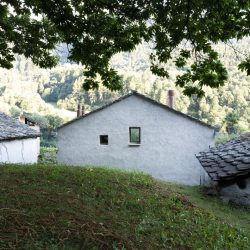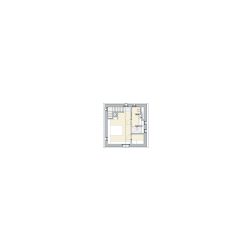
Ruinelli Associati . photos: © Marcello Mariana
The Studio Cascina is situated in the field behind the building complex of the Villa Garbald. The house is a reconstruction of the former chestnut kiln that once stood here and has the same location, volume and height – not only because this is what the building regulations prescribe, but also because the architects sought to establish a sensitive approach to the development and to the landscape.
The project references local traditions and interprets them anew. The building, intended as a location for limited working visits by researchers, is kept to the essentials in its dimensions and functions. In a contemporary fashion, it also alludes to the original craft practised here. Everything has been made «by hand»: the rough exterior rendering, the tamped concrete walls, the mortar flooring on the ground floor and stairs, the chestnut doors, windows, furniture and cladding, the industrial bronze lamps and the ceramic basin, created by a local artist. The result is architecture in which the attention to detail in execution and the mood of the materials are clearly discernible. A space that engages visitors emotionally.
_
La cascina si trova nel prato dietro al complesso della villa Garbald. Il progetto consiste nella ricostruzione con posizione, volume e altezza identici all’edificio preesistente, non solo poiché imposto dal regolamento edilizio, ma anche come volontà progettuale di un approccio pacato al tema e al contesto. L’intervento reinterpreta l’esistente con rigore, attraverso i mezzi costruttivi di oggi e pochi segni contemporanei che si esprimono principalmente nella scelta dei materiali. L’edificio, destinato alla residenza temporanea per ricercatori, è ridotto all’essenziale per dimensioni e funzioni, ma tutto è stato disegnato e realizzato con mestiere e artigianalità. Tutto è stato “fatto a mano”: l’intonaco grezzo dell’esterno, le pareti in calcestruzzo battuto, il pavimento del piano terra e delle scale in malta, le opere in castagno (serramenti, mobili, rivestimenti), le lampade in bronzo industriale e il lavandino in ceramica realizzato da un’artista locale.



























